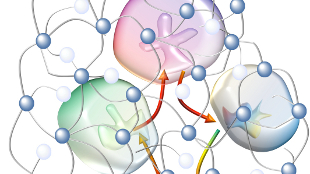Abstract
Proton transfer between the DNA bases can lead to mutagenic Guanine-Cytosine tautomers. Over the past several decades, a heated debate has emerged over the biological impact of tautomeric forms. Here, we determine that the energy required for generating tautomers radically changes during the separation of double-stranded DNA. Density Functional Theory calculations indicate that the double proton transfer in Guanine-Cytosine follows a sequential, step-like mechanism where the reaction barrier increases quasi-linearly with strand separation. These results point to increased stability of the tautomer when the DNA strands unzip as they enter the helicase, effectively trapping the tautomer population. In addition, molecular dynamics simulations indicate that the relevant strand separation time is two orders of magnitude quicker than previously thought. Our results demonstrate that the unwinding of DNA by the helicase could simultaneously slow the formation but significantly enhance the stability of tautomeric base pairs and provide a feasible pathway for spontaneous DNA mutations.
Introduction
In biology, the separation of a DNA duplex occurs via fraying at its terminal base pairs due to random thermal effects or the action of a helicase enzyme during the DNA replication cycle. Once the separation of DNA has started, it will likely propagate down the duplex due to the force cascading down the ribose-phosphate backbone. In the case of helicase enzymes, an active, stepping-motor action pulls on one of the strands of DNA through a narrow opening in the enzyme, thereby forcing apart the nucleobase pairs1.
The interaction of the non-canonical, tautomeric state of a nucleobase pair in DNA within the helicase has thus far been overlooked in the literature. Specifically, the process of DNA strand separation and its impact on proton transfer has been assumed to be simply a matter of comparing the proton transfer timescale (via quantum and classical effects) to the timescales of the biological process.
If a tautomer passes through the replication machinery, it will form a mismatch with the wrong corresponding base on the copy strand. For instance, the tautomer of guanine will pair with thymine instead of cytosine (G–C ↔ G*–C* → G*–T, where the star denotes the tautomeric non-standard form)2,3. Furthermore, the mismatched base pair can evade fidelity check-points of the replisome by adopting a structure similar to a Watson and Crick base pair2,3 resulting in an error in the genetic code and hence a point mutation.
Florian and Leszczynski4 first proposed that for the tautomeric mechanism to be biologically relevant, the tautomers must remain stable during the long process of DNA unwinding and strand separation, which are the prerequisite steps for the synthesis of the new DNA strand by the polymerase. Consequently, the lifetimes of the tautomers should exceed this characteristic time for the base-pair opening ( ~ 10−10s)4.
In the last decade, numerous authors3,5,6,7,8,9,10 argued that the tautomers’ lifetime is much shorter than the helicase separation time. Therefore, no tautomeric population would successfully survive the DNA strand separation by the enzyme. If the G–C tautomer has a short lifetime and reverts to the standard canonical form, the potentially mutagenic point defect is rendered ineffective during the uncoiling process. Subsequently, the tautomer is not propagated into the two single-stranded DNAs. On the contrary, if the tautomeric lifetime is longer than the double-strand separation time, the tautomeric form will survive the biological process. Under closer inspection, the timescale reasoning requires further justification and refinement. Here, we will unpick some of the core assumptions and provide evidence for the need for a more careful investigation of enzyme effects on the DNA tautomers.
In the following sections, we first use quantum chemical models to determine the effect of an induced separation of the two strands of DNA on the structures of the G–C and G*–C* dimers and on the characteristics of the minimum energy pathway linking the two endpoints between the bases. We find that the features of the proton transfer are quasi-linearly correlated with the separation distance. To accompany our quantum chemistry calculations of the G–C dimer, we also evaluate the occurrence of separation events in classically simulated aqueous DNA subjected to a small separation force. We find a wide variety of opening events but reveal a characteristic separation speed unaffected by choice of steering force.
Results
We model the separation of the DNA bases using density functional theory (DFT) at the B3LYP+XDM/6-311++G**11 level of theory (NWChem12) with an implicit solvent. In the DFT calculations, we truncate the model to the G–C dimer, constrain the R-group atom (where the base would join the rest of the DNA), and separate the bases. Figure 1 provides a summary of the scheme. See the Methods section for further information on the separation methods….







